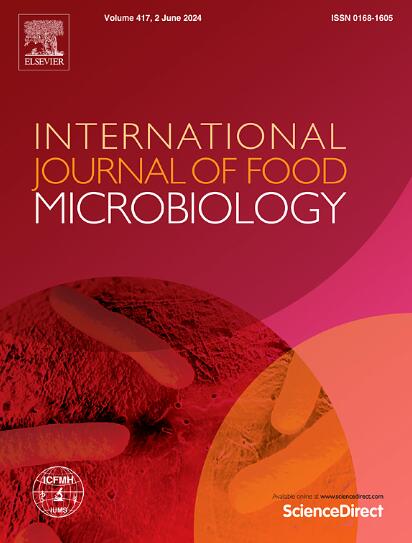开发食品工业和医药表面阪崎肠杆菌和丁香杆菌形成生物膜的预测模型
IF 5
1区 农林科学
Q1 FOOD SCIENCE & TECHNOLOGY
International journal of food microbiology
Pub Date : 2025-02-24
DOI:10.1016/j.ijfoodmicro.2025.111131
引用次数: 0
摘要
阪崎克罗诺杆菌和阴沟肠杆菌表现出形成生物膜的能力,使它们对干燥、抗生素和ph值变化具有抵抗力。这些生物膜可以粘附在不同的表面,包括组织、导管、肠内喂食管和工作表面,潜在地导致食品和医疗部门的交叉感染风险。本研究的目的是建立坂崎肠杆菌和阴沟肠杆菌在37℃的医用聚氯乙烯(PVC)表面和4℃的不锈钢(SS)、聚丙烯(PP)表面以及不同微生物接种浓度下生物膜形成的预测模型。采用染色法和分光光度法测定生物膜的形成情况。采用SyStat Software Inc. for Windows的Table curve 3D v.4.0.05和非线性函数建立预测模型。在4°C条件下,所有分析细菌对SS和PP表面生物膜形成的分析表明,制冷设备中的卫生程序应每天执行,瓶装牛奶的最长安全储存时间为24小时。在37°C条件下,E. cloacae对PVC管表面生物膜形成的风险最高,时间为6-36小时。选择6个最佳生物膜形成响应表面模型进行展示。这些模型中的大多数显示出良好的准确性,证明了低平均标准误差(MSE),高系数R2和调整后的R(Aung和Chang, 20142)。这些模型可用于评估人乳库、新生儿重症监护病房和食品工业工厂等环境中的微生物风险。本文章由计算机程序翻译,如有差异,请以英文原文为准。
Development of predictive models of biofilm formation by C. sakazakii, E. cloacae on surfaces used in the food industry and medicine
Cronobacter sakazakii and Enterobacter cloacae exhibit the ability to form biofilms, making them resistant to drying, antibiotics, and changes in pH. These biofilms can adhere to different surfaces, including tissues, catheters, enteral feeding tubes, and work surfaces, potentially leading to cross-infection risks in both the food and medical sectors. The objective of this study was to develop a predictive model of biofilm formation over time by C. sakazakii and E. cloacae on medical polyvinyl chloride (PVC) at 37 °C and stainless steel (SS), polypropylene (PP) surfaces at 4 °C and different microbial inoculum concentration. A staining method and spectrophotometric measurement were used to assess biofilm formation. SyStat Software Inc. for Windows Table curve 3D v.4.0.05 and non-linear functions were used to develop predictive models. Analysis of biofilm formation on SS and PP surfaces at 4 °C by all analyzed bacteria suggests that hygiene procedures in refrigeration equipment should be performed daily, the maximum safe storage time for bottled milk is 24 h. At 37 °C E. cloacae posed the highest risk of biofilm formation on the surface of PVC tubing at 6–36 h. The six best response surface models of biofilm formation were selected for presentation. The majority of these models demonstrated good accuracy, as evidenced low mean standard errors (MSE), high coefficient R2 and Adjusted R(Aung and Chang, 20142). These models can be utilized to evaluate the microbiological risks in settings such as human milk banks, neonatal intensive care units and food industry plants.
求助全文
通过发布文献求助,成功后即可免费获取论文全文。
去求助
来源期刊
CiteScore
10.40
自引率
5.60%
发文量
322
审稿时长
65 days
期刊介绍:
The International Journal of Food Microbiology publishes papers dealing with all aspects of food microbiology. Articles must present information that is novel, has high impact and interest, and is of high scientific quality. They should provide scientific or technological advancement in the specific field of interest of the journal and enhance its strong international reputation. Preliminary or confirmatory results as well as contributions not strictly related to food microbiology will not be considered for publication.

 求助内容:
求助内容: 应助结果提醒方式:
应助结果提醒方式:


